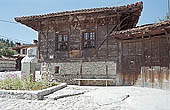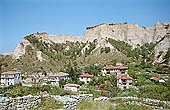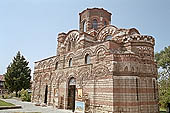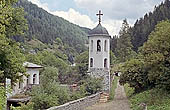During the Ottoman rule, the so called Turkish yoke (xviii-xix centuries), the architectural style known as the Bulgarian National Revival reflected the Bulgarian national identity and its economic prosperity.
The National Revival period is particularly remarkable for its vernacular architecture which can still be observed in small towns and mountain villages that preserved their original aspect, rare examples of house architecture almost impossible to find in modern European towns.
Bulgarian National Revival Architecture |

|
This is the so called wooden architecture of the Plovdiv style, characterised by symmetrical houses with colourful painted facades, bay and lattice windows built in harmony with the environment. They are two storied houses, the first floor is of stone, the second floor, projecting over the street supported by elegantly curved wooden beams, is made of wood and has bay windows. Typical is also the tall stone chimney. Houses are often painted in vivid colours (yellow, orange, red, blue, green). In the yards a drinking-fountain is sometimes present. Lovely carved ceilings, murals and exquisite furniture adorn the interiors.
These were the homes of wealthy merchants who did business within the confines of the Ottoman Empire and Europe, usually hidden behind high stone walls with large wooden doors along curved and narrow cobblestone streets, sometimes the houses are built as little castles where they could protect themselves from the enemies.
Traditional arts had also made progress in church murals, icon painting and carved iconostases.
There are a lot of fascinating Bulgarian town museums that are declared architectural reserve:
Arbanassi with its houses so austere with high solid walls that resemble small fortresses, and the beautiful
mural paintings of its churches.

|
Arbanassi
|
Koprivshtitsa, one of the most charming small Bulgarian towns, is still preserving the atmosphere of the National Revival period, with exquisite painted house facades.
Koprivshtitsa |

|
Melnik beautiful fortress-like houses with broad wine-cellars cut in the limestone rocks

|
Melnik
|
Nessebur on a small peninsula in the Black Sea narrow with its cobblestone lanes, tiny squares, two-storied houses with wooden upper floors jutting above the streets. The architectural heritage of the
Orthodox churches
(x-xi c.) has been listed by UNESCO as world heritage
Nessebur |

|
Plovdiv Old Town where along cobbled lanes lovely houses show their large bay windows that gave their name to this style.

|
Plovdiv Old Town
|
Shiroka Luka is a small town of the Rhodopi mountain that has preserved its original aspect. Here the like houses resemble a fortress with their white-washed protruding bays. Characteristics are the chimneys with their original multiform design.
Shiroka Luka |

|
Sozopol a small fisher town on the Black Sea with wooden houses now turned in a tourist resort.

|
Sozopol
|
|
Related Pages
††-
††-
††-
-
|
|



